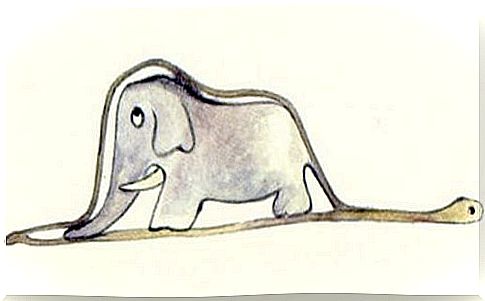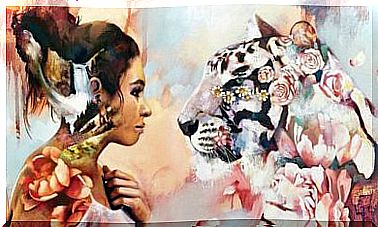Divergent Thinking: What Is It And How Does It Arise?

Divergent thinking or lateral thinking is about generating multiple creative solutions to the same problem. It is a spontaneous, fluid, non-linear mental approach based on curiosity and non-conformity. In fact, it is also a type of thinking very common in children, where joy, imagination and a new perspective make their reasoning more free.
Divergent thinking is important in today’s modern world. In a society accustomed to imitating similar skills, there will come a time when large companies will begin to value other skills. Other dimensions that bring ingenuity and vitality to their projects. Thus, a person who is able to offer innovation and creativity can become an attractive candidate.
However, our schools and universities prioritize a highly convergent mindset in their way of working. In the 1960s , JP Guilford distinguished and defined convergent and divergent thinking.
Although Guilford emphasized the importance of educating children in divergent thinking, educational institutions have paid little attention to him. In general, they have given priority to a kind of reflection (or lack thereof) in which the student has to use linear thinking, rules and structured processes to arrive at the only ‘right’ solution.
While this strategy is useful and necessary in many cases, we must admit that real life is complex, dynamic and imprecise enough that it is unrealistic to think that problems have only one solution. That’s why we need to learn how to really use divergent thinking.
Many educational centers encourage their students to do more than just find the right answer. The goal is to be able to ask new questions.

Divergent thinking and psychological processes
Before we go any further, it would be good to clarify an idea. No one way of thinking is better than another. Convergent thinking is useful and necessary in many cases. The real problem, however, is that we’ve been “trained” to think only this way. We have neglected spontaneity, humor and captivating freedom.
In many courses aimed at training people in divergent thinking, students are asked questions such as these:
- What kind of things can you do with a rock and a pen? What uses could you think of if we gave you a toothbrush and a toothpick?
At first, it may be difficult to come up with even one idea. However, some people are able to come up with multiple answers and ingenious ideas because they are good at what Edward de Bono calls “lateral thinking.” To understand a little better how this works, let’s take a look at what kinds of psychological processes are involved.

Semantic networks, or the connection theory
Divergent thinking is the ability to find relationships between ideas, concepts, and processes that do not appear to be similar at first glance. Psychologists who are experts in creativity say that people have different mental networks of association:
- People with ‘steep’ semantic networks are more subject to logic and linear thinking.
- People with ‘flat’ semantic networks have mental connections that are much more connected. That is, sometimes they connect two things that don’t make sense, but other networks cooperate and an ingenious idea results.
Right and left brain hemispheres
We’ve all heard that the right hemisphere is the creative side and the left hemisphere is the logical side. Therefore, people who use more divergent or lateral thinking are more likely to use the right hemisphere, according to this theory. Well, we have to be careful with this kind of generalization about lateralization or cerebral dominance, because it’s actually a very nuanced process.
We cannot see the brain as an entity with clearly separated areas. In fact, we use our whole brain when we generate an idea, be it ingenious, conservative, logical or highly creative. After all, the key lies in how we connect one idea to another. The most ingenious people use tree-like thought processes. In other words, they make connections in both sides of the brain, not just one.

How can I train myself in divergent thinking?
As we said, regardless of our age, we can practice and improve our divergent thinking. To do this, we will focus on four areas in particular:
- Fluency: the ability to produce a large number of ideas.
- Flexibility: the ability to create a wide range of ideas based on different areas of knowledge.
- Originality: the ability to create innovative ideas.
- Development: the ability to improve our ideas, to make them more advanced.
Here are two ways to improve the above areas:
Synectics Exercises
‘Synectics’ is a term coined by psychologist William JJ Gordon. In short, it means that you can make connections and relationships between concepts, objects and ideas that seem unrelated. This exercise takes a lot of mental work. We can do it daily by choosing the concepts ourselves. For example:
- What can I do with a paperclip and a spoon?
- What relationship could there be between the Limpopo River in Africa and Lake Baikal in Siberia?
The Scamper Method
The Scamper method is another creative idea development strategy developed by Bob Eberle. It is very useful to create something innovative and practice divergent thinking. For example, let’s say we need to come up with an idea for work. Once we have that ‘idea’, we will run it through a series of ‘filters’.
- Replace one element of that idea with another (What can we change in how we have fun? And in how we work?).
- Now combine everything (What can we do to make our work more fun?).
- Adjust it (What do people in other workplaces do to be less stressed?).
- Change it. (How can we work without getting stressed?).
- Give it other uses (What is there at work that I could do in a nicer way?).
- Delete something (What if you go to work a little earlier to make better use of the day?).
- Reform it (What would happen if I…dare to do?).

Divergent thinking and your mood
Research by psychologist Nina Lieberman in the very interesting book ‘Playfulness: The Relationship with Imagination and Creativity’ has something very relevant to add to this discussion. Divergent thinking goes hand in hand with joy, optimism and inner well-being. Having good relationships, being well rested and free from pressure, anxiety and stress puts you in an ideal position for divergent thinking.
With our busy lives, we neglect many of these valuable dimensions. Therefore, we can also conclude that this kind of thinking also stems from a certain attitude to life: free, cheerful, non-conformist, open to new experiences…









